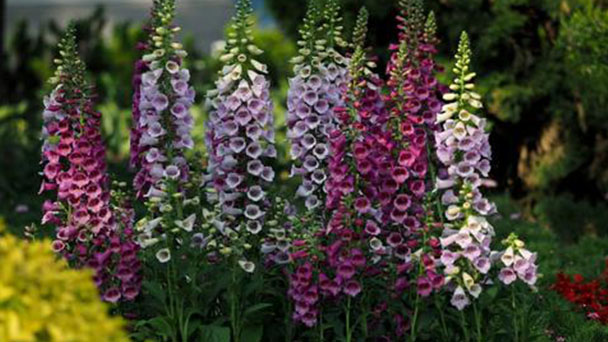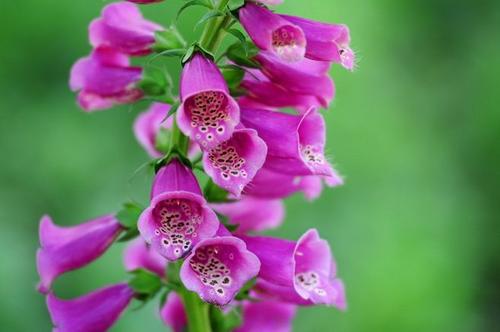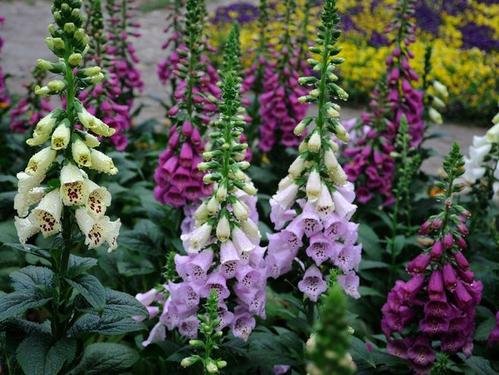Digitalis purpurea (foxglove) profile
Written by Maggie
Feb 26 2021

Foxglove (Digitalis purpurea L), also called Lady's glove, is a biennial or perennial herb. Except corolla, Foxglove is grayish-white pubescent and glandular hairs, sometimes glabrous on stems, 60-120 cm tall. Stem is solitary or several clusters. Leaf blade is ovoid or ovoid lanceolate, leaves rough, wrinkled, basal leaves long petiolate, ovate to ovate-lanceolate, leaf margin with circular serrate, petiole with narrow wing, leaf shape from bottom to top tapered. The terminal racemes are 50 -- 80cm long, corolla campanulate to 7.5cm, corolla waxy purplish red with pale white spots on the inside. The bud fruit is ovoid, the flowering period is 5~6 months, the fruit ripe period is 8~10 months, the seed is very small. Artificial cultivated varieties are white, pink and deep red, generally divided into white flower Liberty Bell, large flower Liberty Bell, double petals Liberty Bell. Foxglove is often used in flower borders, flower beds and rock gardens, but also for natural flower arrangement.
Foxglove picture

The morphological characteristics of foxglove
Stems
Foxglove is a biennial or perennial herb, covered with grayish-white pubescent and glandular hairs except for corolla, sometimes glabrous on the stem, 60-120 cm tall.Stem solitary or several clusters.
Leaf
The basal leaves of Foxglove are mostly rosette, petiole narrowly winged and up to 15 cm long.Leaf blade ovate or oblong-elliptic, 5-15 cm long, apex acute or obtuse, base attenuate, margin crenate with mucronate, rarely serrate; Lower part of cauline leaves are homomorphic to basal leaves, tapering upward, petiole short to sessile and becoming bracts.
Flowers
Calyx of Foxglove is campanulate, ca. 1 cm long, fruit slightly enlarged, 5-lobed to base;Lobes rectangular oblong-ovate, apex obtuse to acute; Corolla is purplish red, inner mask spotted, 3-4.5 cm long, lobes very short, apex covered with white pilose.
Fruit
The capsule of Foxglove is ovate, about 1.5 cm long. Seed is short clavelike, except by honeycomb reticulate outside, still has very fine pubescence.
The ecology of foxglove
Foxglove plants are strong, tolerant to cold, drought, heat and barren soil.
FoxGlove is sunny and shade-tolerant, and is ideal for growing on moist, well-drained soil.
Propagation of foxglove
Foxglove commonly used for sowing propagation, cultivation seedlings move cultivation direct seeding. General 10 a.m. or so to open the thin seat, at 4 p.m. to cover the seat to promote moisture. When the seedlings grow to 3-5 leaves in spring, transplant foxgloves to the field according to the row spacing of 30cm×20cm, and water them after planting. The direct seeding method saves labor. In the north, the seeds are sown after the soil thaws in spring, or before the soil freezes in winter. In the south, foxglove is better to sow in late autumn. Direct seed sowing can be used, or can be used 20℃ warm water germination sowing.Sowing row spacing is 30cm, sowing depth is about 1cm.
Growing methods of foxglove
Seedling of foxglove should pay attention to timely watering and weeding soil, in order to reduce disease. Water immediately after transplanting to promote slow seedlings.
Fertilization requires a large amount of fertilizer and prefers a continuous 100ppm ~ 150ppm liquid nitrogen fertilizer (15:5:15 or 15:10:15) with a humidity level between 2 and 4 standard (humidity standard 4 means that the moisture of the substrate is maintained at a level that is perceived to be moist but not saturated at contact). During the foxglove flowering season, light can be increased appropriately, considering the quality and quantity of flowers. The length of daylight does not affect flowering. Although Foxglove is a shade loving plant, foxglove can grow under certain light intensity when there is sufficient humidity and moderate low temperature. Before flowering, foxgloves have eight to 12 leaves. Although the temperature adaptation range of plant growth is between 12℃ and 19℃, the optimal nighttime temperature at the final stage is between 12℃ and 16℃. When foxgloves are planted with a protective cooling bed, they can grow high quality plants and flower ears. On the other hand, if foxgloves were planted in a greenhouse with relatively bright light and nocturnal temperatures above 19 ° C, they would bloom fruitless and sparsely, though they did bloom.

Disease control of foxglove
Symptoms
Victim foxgloves near the soil at the base of the stem of the first dark spots, expanded to brown, shrinkage and decay. The leaves were infected with the pathogen causing dark green watery spots. The infected petiole was brown and rotten. White filamentous material can be seen in the spot when wet, and the seriously ill plant is inverted. The law of disease: the germ does not produce spores, but spreads to people by mycelium infection. Mycelium initial colorless, later light brown. The decay is strong. Overwintering in soil or diseased tissue. The temperature is suitable (20-24 degrees) and the humidity is large, which is conducive to the growth and reproduction of bacteria. Begonia plant or cuttage propagation caused by wounds, or in rainy weather, excessive watering, soil water is easy to be infected by bacteria, causing serious disease, plant decay and death.
Method of prevention and cure
(1) Choose new soil with rich organic matter or dried pond mud and river mud with darker color and solid texture and less mud powder when broken mud as cultivation soil. It's best not to use old pots of soil. The base fertilizer applied should be well decomposed.
(2) Strengthening field management. When air humidity is large, water less or not water, in order to keep the soil in the basin moist. Apply less nitrogen fertilizer and more phosphorus and potassium fertilizer. Remove the diseased leaves and old leaves of foxglove that touch the soil in time and destroy them.
Pathogen
Aspergillus Niger vanteigh, a semi-known bacterium; Harmful symptoms: diseased plant leaves light green. Most of the foxglove leaves left by cutting hemp were wet rot in the form of water stains, producing yellow-brown or reddish-brown disease marks, and there is juice flowing out of the hand pressure. The rot gradually spreads to the base of adjacent uncut leaves, the infected tissue is wet rot, and the hemp leaves are wilting and drooping. Wet rot of leaf base and stem tissue odorous. In the longitudinal dissection of the trunk of the infected plant, it can be seen that the yellow brown fertilizer necrotic mark is formed from the infected leaf base inward, and there is a red halo at the junction of the infected foxglove. Many black mildew can be seen in the incision of leaf pile and the center of leaf axis.
Method of prevention and cure
(1) Application of lime: application of lime can not only prevent disease, but also increase, but also improve the rate of hemp.0.5kg/ plant in general diseased field and 0.25kg/ plant in non-diseased field were applied continuously for 2 ~ 3 years.
(2) Adjust the cutting period: the cutting period of susceptible and susceptible fields can be adjusted to the low wet period. The original leaves cutting before June was advanced to the first ten days of March; The original summer leaf cutting was postponed to winter. Be careful not to reverse blade cutting;
(3) Drug control: in susceptible and susceptible fields, the cutting mouth should be sprayed with 40% carbendazim 200 times or 25% carbendazim 400 times liquid within 3 days after leaf cutting, the dosage of liquid is 20 ~ 25kg/666.7m2; (4) Cultivate and plant disease-resistant varieties.
The distribution area of foxglove
Foxglove was originally produced in Europe and cultivated sporadically in Taiwan.
Foxglove has been naturalized in a large number of places such as Ali Mountain, Taiping Mountain, Qingjing Farm and South Tianchi Lake.
Foxglove toxicity
Digitalis is an important stubborn heart medicine, can stimulate the heart muscle, increase the contractility of the heart muscle, improve blood circulation, or directly inhibit the heart conduction system, slow the heart rate, the main treatment of chronic congestive heart failure, cardiac edema has a significant diuretic swelling effect, but the savings effect, should pay attention to when. Due to the small distance between the therapeutic dose and the toxic amount of digitalis drugs (generally believed that the therapeutic dose is about 60% of the toxic amount and 10 ~ 20% of the lethal amount), it is easy to be poisoned. The whole plant is poisonous, medicinal and has the effect of a stubborn heart.
Foxglove poisoning performance
Causes inappetence above all in intestines and stomach way, nauseous vomit (stomach content is grass green), anorexia, salivate, abdominal pain diarrhea, occasionally see hemorrhagic gastritis and ache below sternum. It is more common in adults. Another early sign is a lack of urine. The symptom of cardiac respect is the arrhythmia of all sorts of types coexist or appear successively, be like tachycardia or too slow, the rhythm of the heart changes like premature pulsation, two joint law, paroxysmal tachycardia, ventricular fibrillation, all levels of atrioventricular conduction obstruction. Ventricular fibrillation and ventricular quiescence are the most serious arrhythmias and can be directly life-threatening. Finally, convulsions, collapse, coma and so on.
Foxglove poisoning treatment
If overdose of foxglove endangers arrhythmia, immediately use 2 ~ 5 g of antidote or tannin protein.Intravenous drip, etc., as opposed to supportive therapy for arrhythmias.
Foxglove landscaping use
foxglove is suitable for pot planting and will flower in early spring if cultivated in a greenhouse. Because of its tall, beautiful inflorescences, foxgloves can be used in flower borders, flower beds, rock garden. Foxgloves can make natural flower arrangement. Foxglove is an important medicinal material.

Latest Updated
- Benefits of Bugleweed - 7 Science-backed Health Benefits
- Bugleweed Dangers & Side Effects - Is It Poisonous?
- How to Plant Evergreen Trees - What You Should Know
- When to Plant Evergreens - Grow Guide for Evergreen Trees
- 12 Wonderful Evergreen Shrubs for Your Garden
- 12 Popular Evergreen Plants with Pictures for Beginners
- When And How To Prune A Lilac Bush Like a Pro
- How to Grow & Care for Lilac Vine (Hardenbergia Violacea)
- Japanese Lilac Tree (Syringa Reticulata) Care & Propagation Guide
- Shumard Oak Pros and Cons - What to Know
Popular Articles
- Winter maintenance of Antirrhinum Majus
- How to Grow Terminalia Mantaly Tree
- How to Grow and Care for Crossostephium Chinense
- How to grow Antirrhinum Majus in spring
- Peristeria Elata (Dove Orchid) Profile: Info & Care Guide
- Underwatered Snake Plant (Sansevieria Trifasciata) - Signs And How To Fix
- How to Care for Brazilian Jasmine Plant (Mandevilla Sanderi)
- How to Grow & Care for Graptopetalum Purple Delight in Summer
- Rosa Chinensis (China Rose): Plant Growing & Care Tips
- How to Care for Baby Sun Rose (Aptenia Cordifolia)